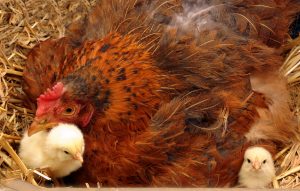Chickens have minds of their own. Broodiness proves it. When a flock owner wants a broody to mother a new generation of chicks it’s certain that no hens want anything to do with motherhood. But, when that person needs the hens to lay lots of eggs, many will decide to go broody. It can be maddening.
One way to think about this is to remember that few chicken raising aspects are as fascinating as watching a broody hen incubate and mother a brood. It’s also an easy way to acquire new chicks to replace aging hens.
Broodiness
Before scientists developed hyper-efficient egg laying breeds and invented incubators all baby chicks started life under broody hens. Chicken keepers kept banks of nests specially for their broodies. Today, hatchery chicks start life in an incubator and never know their mother.
Broodiness happens any time of the year but is most common as spring’s days lengthen. When a hen fluffs her feathers, changes her cluck tones, stops laying and spends hours in the nest she’s broody.

Geneticists created chicken breeds and hybrids that lay lots of eggs and rarely go broody. These include Leghorns, Rhode Islands, and many hybrids, but every once in a while, even one of these “non broody” breeds decides it’s time to be a mom and goes broody. In contrast, some breeds are matronly champions. Silkie bantams famously go broody often and larger breeds with fluffy feathers, like Orpingtons and Brahmas, tend to go broody. No rules are airtight and sometimes nary a single hen of a “broody” breed will fluff up and sit on eggs.
Anyone wanting or not wanting broody hens should pay attention to the fine print in the Hoover’s catalog and order breeds that tend to, or not to, go broody.
If a hen goes broody and the owner doesn’t want chicks, she can be discouraged by isolating her in a nestless coop with a wire mesh floor. That seems harsh but she’ll eventually give up sitting and start laying again.
A family with a few hens is in for a treat when one goes broody. Helping and watching her is fun and educational for both children and parents, and it’s an easy way to raise replacement hens.
Here are steps for helping her successfully raise a brood:
- Isolate the broody. It’s best if she has private quarters to keep other hens from laying in her nest. She won’t need much space, and a large dog transport box can function well as a broody coop. Put a nest and hen inside along with food and water.
- Sit her on fertile eggs. Lacking a rooster, eggs are infertile and won’t hatch. Sometimes someone nearby has a flock with roosters. They’ll likely give or sell a dozen eggs, but rarely is there a choice of breeds. Fertile eggs can be ordered online. They’re expensive but do give a customer breed options.
- After dark bring a flashlight and fertile eggs into the coop. Gently remove infertile eggs from under the hen and replace them with fertile ones. Large hens can incubate a dozen.
- Buy chick starter feed. It has a higher protein content than layer feed. Have it ready before the eggs hatch.
- Be ready for excitement on the 21st day when chicks peck and push their way out of the eggshells. Avoid the temptation to “help” the chicks crack out of the shell. They need to emerge themselves. They’ll sit under mom until they dry out but will soon perch on her back and begin exploring the coop, drinking, and pecking at feed.
- Sometimes mom and babies can be let back into the flock. Do it carefully. Occasionally older hens will harass chicks. If this happens keep them separate until they are larger. If not let them mingle.
- Mom will take good care of her babies. She’ll warn them of danger, show them what’s good to eat, and keep them snugly warm in the embrace of her feathers.
After six- or eight-weeks mom will tire of motherhood as her chicks become fully feathered and independent. She’ll go back roosting with her flock mates and eventually start laying again. About half the new chicks will be roosters. They can be butchered when ten to 16 weeks old or given away.
There’s a slick trick to avoid trying to find fertile eggs yet allow the broody to be a mom.
Chickens are amazingly smart, but they can’t count. So, a broody will sit on eggs until they hatch. If there’s no rooster in the flock and a hen goes broody, isolate her as mentioned above and let her sit on infertile eggs……or even golf balls.
Immediately order chicks from Hoover’s Hatchery to arrive soon or buy them at a farm store. The Hatchery will ship as few as 15, and they can be all females of a wide array of breeds. When the chicks arrive, bring them to their future adoptive mother after dark. Gently remove the infertile eggs or golf balls from under her and replace them with chicks.
Those peeping babies will bring her out of her near trancelike condition, and she’ll happily adopt them. Whether she hatches her own fertile eggs or foster parents hatchery chicks the hen will be a proud and capable mother.